

Path to Zero Energy Buildings. Fuel Cell States Web. Type Deployment Category Stationary Fuel Cells/Power Generation TitleFreedom Tower - World Trade Center StateNew York CityNew York City Fuel Cell ManufacturerUTC Power Fuel Cell TypePAFC Year DeployedPlanned DetailsThe 4.8 MW of PureCell Model 400 fuel cells will provide heat and power for Freedom Tower, the rebuilt World Trade Center complex in New York City.

In October 2010, six fuel cells were delivered to the World Trade Center construction site, for eventual use in Towers 3 and 4. The project includes a collaboration of Port Authority, Silverstein Properties, and the New York Power Authority (NYPA). The 4 World Trade Center building is registered for Gold certification under the USGBC’s LEED for New Construction rating system.
Future Buildings Forum. Status: Ongoing (1991 - ) Chairman: Dr Markku Virtanen Email: Markku.Virtanen@vtt.fi The Aim of the Forum The Future Buildings Forum has been established to identify long-term energy, environmental, economic, and technological issues, assess their potential effect on future buildings, and encourage research projects on these issues that will help to ensure that buildings contribute to a sustainable society by the year 2025 and beyond.
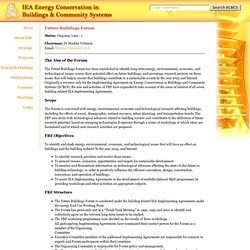
Originally a resource only for the Implementing Agreement on Energy Conservation in Buildings and Community Systems (ECBCS), the role and activities of FBF have expanded to take account of the areas of interest of all seven building related IEA Implementing Agreements. Scope The Forum is concerned with energy, environmental, economic and technological research affecting buildings, including the effects of social, demographic, natural resource, urban planning, and transportation trends. FBF Objectives To identify research priorities and resolve these issues. Building Integration with Smart Grid. Objective: To develop the measurement science for industry standards that will enable interconnection of home and building automation and control systems with a future “smart” utility grid, provide consumers with energy usage information, and support industry efforts to develop the needed standards by 2015.
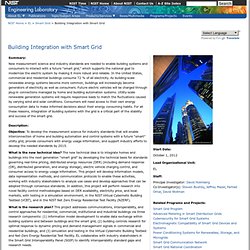
What is the new technical idea? The new technical idea is to integrate homes and buildings into the next generation “smart grid” by developing the technical basis for standards governing real-time pricing, distributed energy resources (DER) (including demand response (DR), distributed generation, and energy storage), electric vehicle charging control, and consumer access to energy usage information. This project will develop information models, data representation methods, and communication protocols to enable these activities, working with industry stakeholders to analyze use cases and develop approaches that can be adopted through consensus standards.
What is the research plan? Estimating Appliance and Home Electronic Energy Use. Water ‘Directly Responsible’ for 12.6% of US Energy Use. October 4, 2012 Over 12 percent of US energy use is directly related to water consumption, according to research from The University of Texas at Austin.
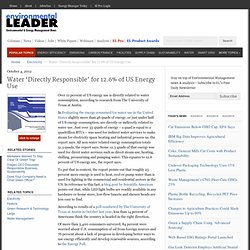
In Evaluating the energy consumed for water use in the United States slightly more than 46 quads of energy, or just under half of US energy consumption, are directly or indirectly related to water use. Just over 33 quads of energy – a quad is equal to a quadrillion BTUs – was used for indirect water services to make steam for electricity space heating and industrial process us, the report says. All non-water related energy consumption totals 51.5 quads, the report says. Some 12.3 quads of that energy was used for direct water services such as direct steam use, heating, chilling, pressurizing and pumping water.
Building Integrated Photovoltaics (BIPV) Home > Building Integrated Photovoltaics (BIPV) by Steven StrongSolar Design Associates Last updated: 12-27-2011 Introduction One of the most promising renewable energy technologies is photovoltaics.
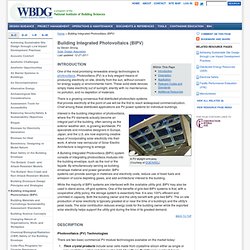
Photovoltaics (PV) is a truly elegant means of producing electricity on site, directly from the sun, without concern for energy supply or environmental harm. There is a growing consensus that distributed photovoltaic systems that provide electricity at the point of use will be the first to reach widespread commercialization. Achieving Superior Energy Performance - Overview. Texas Heat Wave, August 2011: Nature and Effects of an Electricity Supply Shortage - Today in Energy. September 9, 2011 Source: U.S.
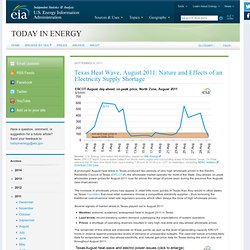
Energy Information Administration, based on SNL Energy. Note: ERCOT North Zone includes Dallas/Fort Worth metro region and surrounding areas of Northeast Texas. On-Peak refers to the 16-hour time block from hours ending 7:00 a.m. to 10:00 p.m. CDT on weekdays, excluding NERC holidays.Download CSV Data A prolonged August heat wave in Texas produced two periods of very high wholesale prices in the Electric Reliability Council of Texas (ERCOT), the wholesale market operator for most of the State. The increase in wholesale prices may appear in retail bills more quickly in Texas than they would in other states, as Texas mandates that most retail customers choose a competitive electricity supplier – thus removing the traditional cost-of-service retail rate regulatory process which often delays the blow of high wholesale prices.
Several signals of market stress in Texas played out in August 2011: Source: U.S. Weather High. Peak Demand. Center for the Built Environment. Regulatory Requirements Database for Small Electric Generators. Apps1.eere.energy.gov/buildings/publications/pdfs/corporate/bt_stateindustry.pdf.